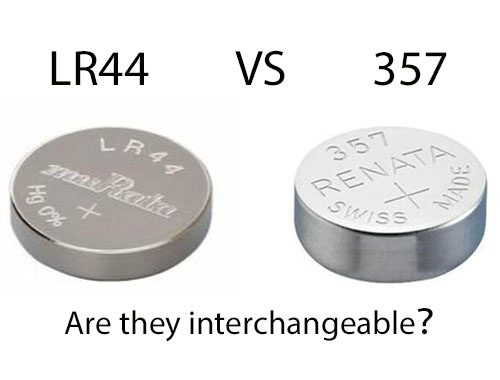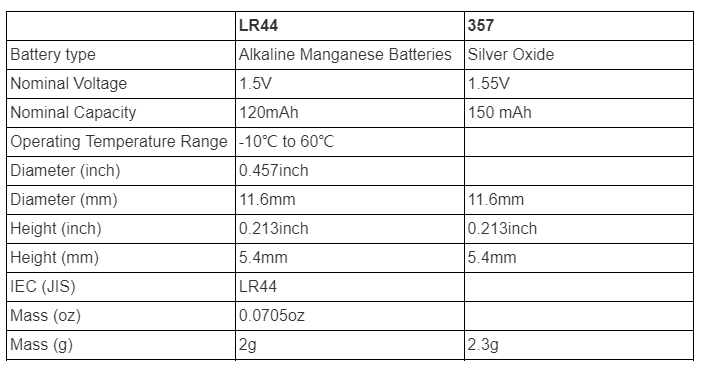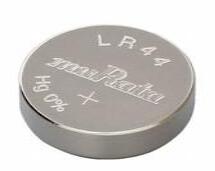The LR44 and 357 batteries are not directly interchangeable, although they have some similarities. Here are the key differences between them:
-
Size: The LR44 battery is a button cell battery with a diameter of 11.6 mm and a thickness of 5.4 mm. The 357 battery, also known as SR44, is slightly larger, with a diameter of 11.6 mm and a thickness of 5.4 mm.
-
Voltage: The LR44 battery is a 1.5V alkaline or silver oxide battery. On the other hand, the 357 battery is a silver oxide battery with a voltage of 1.55V. While the voltage difference is small, it can affect the performance of devices or circuits that rely on precise voltage levels.
-
Capacity: The LR44 battery typically has a lower capacity than the 357 battery. This means that the LR44 battery may not provide the same amount of energy or longevity as the 357 battery.
Due to these differences in size, voltage, and capacity, it is generally not recommended to interchange LR44 and 357 batteries without consideration for the specific requirements of the device. Always consult the device's user manual or specifications to determine the appropriate battery type and voltage it requires. Using the wrong battery can lead to improper device operation or potential damage.
LR44 vs. 357: Difference in Specifications
The LR44 and 357 batteries have some differences in their specifications. Here's a comparison of their key specifications:
-
Size and Shape: The LR44 and 357 batteries have the same size and shape. They both typically have a diameter of 11.6 mm and a height of 5.4 mm.
-
Chemistry: The LR44 battery is available in both alkaline and silver oxide chemistry options. The 357 battery, on the other hand, is primarily a silver oxide battery.
-
Voltage: The LR44 battery typically has a nominal voltage of 1.5 volts in alkaline chemistry and 1.55 volts in silver oxide chemistry. On the other hand, the 357 battery typically has a constant voltage of 1.55 volts due to its silver oxide chemistry.
-
Capacity: The capacity, or the amount of energy a battery can store, can vary between different brands and qualities. However, in general, the LR44 battery has a slightly lower capacity than the 357 battery.
-
Applications: Both LR44 and 357 batteries are commonly used in a wide range of small electronic devices, as mentioned earlier.
-
Interchangeability: Despite the differences in voltage and chemistry, LR44 and 357 batteries are often interchangeable in many devices. This is because their physical dimensions are the same, and the slight difference in voltage may not significantly affect the performance of most devices.
It's important to note that these specifications can vary between different manufacturers and brands. When choosing between LR44 and 357 batteries, it is best to consult the device's specifications or user manual to determine the recommended battery type and voltage for optimal performance.
LR44 vs. 357: Difference in Features
When it comes to their features, the LR44 and 357 batteries have some notable differences. Here are the key distinctions:
-
Chemistry: The LR44 battery is available in alkaline and silver oxide chemistry options. Alkaline LR44 batteries are more readily available and usually cost less, but they may have a slightly shorter lifespan compared to silver oxide LR44 batteries. The 357 battery, on the other hand, is primarily a silver oxide battery, known for its longer-lasting power.
-
Voltage Stability: The LR44 battery, regardless of its chemistry, exhibits a gradual decrease in voltage as it discharges. On the other hand, the 357 battery maintains a relatively stable voltage output over its lifetime. This feature can be important for devices that rely on consistent voltage levels for optimal performance.
-
Shelf Life: The silver oxide chemistry used in the LR44 and 357 batteries contributes to their extended shelf life compared to other battery types. The 357 battery generally has a longer shelf life, meaning it can be stored for an extended period without significant loss of power.
-
Cost: The cost of LR44 and 357 batteries can vary. Alkaline LR44 batteries are generally more affordable than silver oxide LR44 or 357 batteries. However, silver oxide LR44 or 357 batteries, while more expensive, offer longer-lasting power and better voltage stability.
-
Availability: Both LR44 and 357 batteries are widely available, and you can find them in various electronic and retail stores, as well as online marketplaces. However, the alkaline LR44 batteries are typically more common and easier to find compared to silver oxide LR44 or 357 batteries, which may have a more limited availability.
When selecting between LR44 and 357 batteries, consider the specific requirements of your device, such as its voltage sensitivity, expected lifespan, and the battery chemistry recommended by the manufacturer. This ensures optimal performance and maximizes the longevity of your device.

LR44 vs. 357: Difference in Dimension Outline
The LR44 and 357 batteries have the same dimensions, and their outline is identical. Here are the common dimension specifications:
-
Diameter: Both LR44 and 357 batteries typically have a diameter of 11.6 mm.
-
Height: The height of both LR44 and 357 batteries is approximately 5.4 mm.
-
Shape: Both batteries have a cylindrical shape with a flat top and a flat bottom. The positive terminal is located on the flat top, while the negative terminal is on the flat bottom.
Due to their identical dimensions, LR44 and 357 batteries can be physically interchanged in devices that accommodate this size. It's important to note, however, that the electrical characteristics and chemistry of the batteries may differ, as discussed in previous responses. Always refer to the device's specifications or user manual to determine the appropriate battery type and voltage for optimal performance and safety.
Alkaline LR44 Battery vs. Silver-Oxide 357 Battery
The alkaline LR44 battery and the silver-oxide 357 battery have some significant differences in their characteristics and performance. Here's a comparison between the two:
-
Chemistry: The LR44 battery is available in both alkaline and silver-oxide chemistry options, whereas the 357 battery is primarily a silver-oxide battery. The chemistry used affects the battery's voltage output and longevity.
-
Voltage: The alkaline LR44 battery has a nominal voltage of 1.5 volts, while the silver-oxide 357 battery typically maintains a constant voltage of 1.55 volts. This voltage difference can be important for devices that require precise voltage levels to operate correctly.
-
Capacity: Generally, silver-oxide batteries, including the 357, have higher energy capacities compared to alkaline batteries like the LR44. This means that the 357 battery can typically provide more power and last longer before it needs to be replaced.
-
Voltage Stability: Silver-oxide batteries, including the 357, exhibit a more stable voltage output throughout their discharge cycle. On the other hand, alkaline LR44 batteries gradually decrease in voltage as they discharge, which can impact the performance of devices that are more sensitive to voltage variations.
-
Shelf Life: Silver-oxide batteries have a longer shelf life compared to alkaline batteries. The 357 battery, due to its silver-oxide chemistry, can be stored for a more extended period without significant power loss, making it a better choice for devices that may be used infrequently.
-
Price: Silver-oxide batteries are generally more expensive than alkaline batteries. If cost is a significant consideration, alkaline LR44 batteries may be a more economical option.
When choosing between the alkaline LR44 and silver-oxide 357 batteries, consider the specific needs of your device. If your device requires a stable voltage or has a higher power demand, the 357 battery may provide better performance. However, if cost is a primary concern or your device is not as voltage-sensitive, the alkaline LR44 battery can be a suitable choice. Always refer to the device's specifications or consult the manufacturer to determine the recommended battery type for optimal performance.

Are LR44 and 357 cells interchangeable?
LR44 and 357 batteries are often considered interchangeable because they share the same physical size and shape. However, there are some important differences between them that may affect their compatibility in certain devices:
-
Voltage: LR44 batteries typically have a nominal voltage of 1.5 volts, while 357 batteries (also known as SR44 batteries) generally have a constant voltage of 1.55 volts. Though the voltage difference is small, it can impact the performance of devices that require precise voltage levels. It's crucial to check if the device can tolerate the slight variation in voltage.
-
Chemistry: LR44 batteries are available in alkaline or silver oxide chemistry options, whereas 357 batteries are primarily silver oxide batteries. Silver oxide batteries tend to have better voltage stability and longer life compared to alkaline batteries. The different chemistry can influence the performance and longevity of the device in which they are used.
-
Capacity: 357 batteries generally have a higher capacity when compared to LR44 batteries. This means that 357 batteries can provide more energy and potentially last longer before needing replacement.
Considering these factors, it is recommended to consult the device's specifications or user manual to determine the appropriate battery type and voltage it requires. While LR44 and 357 batteries may be physically interchangeable in some devices, it's important to consider the specific requirements of the device in terms of voltage sensitivity and performance expectations. Using the incorrect battery type or voltage can result in improper device operation or potential damage.

Comparison of Alkaline vs. Silver-Oxide Battery
Alkaline batteries and silver-oxide batteries are two common types of primary (non-rechargeable) batteries. Here's a comparison of their key characteristics:
-
Chemistry: Alkaline batteries use an alkaline electrolyte, typically potassium hydroxide, while silver-oxide batteries use a silver oxide electrolyte. The chemistry difference affects their voltage stability, energy density, and overall performance.
-
Voltage: Alkaline batteries typically have a nominal voltage of 1.5 volts, whereas silver-oxide batteries commonly have a nominal voltage of 1.55 volts. The slightly higher voltage of silver-oxide batteries can be advantageous in devices that require a consistent and stable voltage output.
-
Capacity: In general, silver-oxide batteries have a higher energy density and capacity than alkaline batteries. This means that silver-oxide batteries tend to last longer and provide more power before they are depleted.
-
Voltage Stability: Silver-oxide batteries offer better voltage stability throughout their lifecycle. They maintain a relatively constant voltage output until they are nearly depleted. Alkaline batteries, on the other hand, gradually decrease in voltage as they discharge, which can affect the performance of devices that are sensitive to voltage variations.
-
Shelf Life: Silver-oxide batteries have a longer shelf life compared to alkaline batteries. They can be stored for extended periods without significant power loss. Alkaline batteries, although generally having good shelf life, may discharge slowly over time, particularly in demanding conditions.
-
Cost: Silver-oxide batteries are typically more expensive than alkaline batteries. The higher cost partly reflects their superior performance and longer-lasting power.
-
Applications: Alkaline batteries are commonly used in a wide range of devices, such as remote controls, flashlights, toys, and various consumer electronics. Silver-oxide batteries are frequently used in precision instruments, watches, calculators, medical devices, and other electronics that require a stable voltage output and longer life.
Ultimately, the choice between alkaline and silver-oxide batteries depends on the specific requirements of the device. If voltage stability, longer life, or higher power demand are crucial, silver-oxide batteries may be preferred. On the other hand, alkaline batteries are widely available, more cost-effective, and suitable for general-purpose applications.
Frequently Asked Questions
What battery is equivalent to LR44?
LR44 batteries have several equivalent designations, depending on the manufacturer and regional naming conventions. Here are some common equivalent batteries for LR44:
-
AG13: AG13 is one of the most widely recognized equivalents to LR44. It has the same physical size and voltage specifications.
-
A76: A76 is another commonly used designation for LR44 batteries. It is equivalent in size and voltage, making it interchangeable.
-
357: The 357 battery, also known as SR44, is closely compatible with LR44 batteries in terms of size and voltage. However, it is worth noting that the 357 battery is often a silver oxide type, while LR44 batteries can be either alkaline or silver oxide. The slight voltage difference (1.5V for LR44 and 1.55V for 357) may be negligible in many applications.
-
PX76A: PX76A is another designation used for LR44 batteries. It shares the same physical dimensions and voltage characteristics.
-
GPA76: GPA76 is yet another alternative name for LR44 batteries. It is widely used in various devices.
When purchasing replacement batteries, it's essential to verify the specific requirements of the device and consult the user manual or manufacturer's recommendations for the appropriate battery type. This ensures optimal performance and compatibility.
Is an LR44 battery the same as 357?
Yes, LR44 and 357 batteries are essentially the same in terms of physical size and shape. LR44 is the designation commonly used for the alkaline version of this battery, while 357 is the designation used for the silver oxide version.
Both LR44 and 357 batteries have a diameter of 11.6 mm and a thickness of 5.4 mm. Their voltage is also very similar, with LR44 typically having a nominal voltage of 1.5 volts, and 357 batteries generally maintaining a constant voltage of 1.55 volts.
While LR44 and 357 batteries may differ slightly in chemistry and voltage, they are often considered interchangeable in most devices that accept these battery types. It's important to note that the specific requirements of the device should always be taken into consideration, and it's best to consult the device's user manual or manufacturer's recommendations to ensure the appropriate battery type is used for optimal performance.
Do LR44 batteries have silver?
The majority of LR44 batteries do not contain silver.
LR44 batteries are commonly an alkaline type of battery, and they usually do not contain silver as a primary component. Alkaline batteries typically consist of zinc as the anode, manganese dioxide as the cathode, and potassium hydroxide as the electrolyte. These batteries are designed for general-purpose use in various electronic devices.
On the other hand, silver oxide batteries, such as the silver-oxide 357 battery, do contain silver as a primary component. These batteries have a different chemistry and are often used in devices that require a stable voltage output, such as watches, calculators, and medical devices.
It's important to note that while LR44 batteries are typically silver-free, the term "LR44" itself does not necessarily specify the specific chemical composition of the battery. Different manufacturers may use different chemistries for their LR44 batteries, so it's recommended to check the product specifications or consult the manufacturer for detailed information on the composition of a specific LR44 battery.
Is a 357 battery the same as a LR44?
No, a 357 battery is not the same as an LR44 battery.
The LR44 battery and the 357 battery are different in terms of chemistry, voltage, and capacity. Here are the key differences:
-
Chemistry: The LR44 battery is typically an alkaline battery, while the 357 battery is a silver oxide battery. The chemical composition of the batteries affects their performance and voltage stability.
-
Voltage: LR44 batteries usually have a nominal voltage of 1.5 volts, while 357 batteries (also known as SR44 batteries) have a slightly higher nominal voltage of 1.55 volts. The slight voltage difference may affect the performance of devices that have specific voltage requirements.
-
Capacity: 357 batteries generally have a higher capacity compared to LR44 batteries. This means that 357 batteries can provide more energy and potentially have a longer lifespan.
While LR44 and 357 batteries share the same physical size and shape (11.6 mm diameter and 5.4 mm thickness) and can fit into the same devices, it is important to use the appropriate battery type recommended by the device manufacturer. Using the wrong battery type with a different chemistry and voltage can result in improper device operation or potential damage.





